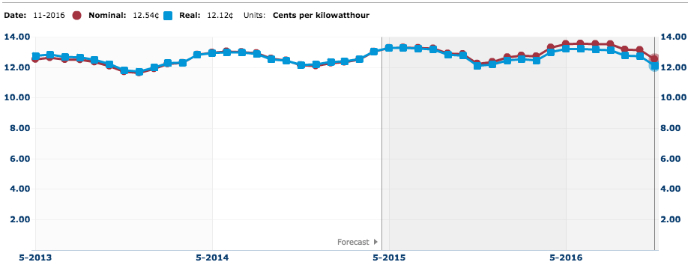Why Are Electricity Prices Higher In The Summer?
Take a look at the picture below. It's a graph from the Energy Information Administration showing monthly changes in retail electricity prices. Notice a pattern? Electricity prices seem to rise during the summer, and then fall during the winter. Hmm, why would that be?

The fluctuation of electricity prices
Well, it turns out that the explanation is pretty simple: demand for electricity tends to increase during the summer, which pushes up prices. Why is this? There are a few factors at play. Almost entirely due to the blasts of cool air that start coming from the armies of air conditioners that get turned on in American homes. 100 million US homes to be exact! (That's a loooot of air conditioners)
Part 1: Increased Demand
Did you know that most American households use more electricity in the summer than in the winter? The biggest culprit here in energy use is air conditioning. Air conditioners are generally the biggest power consuming appliances in a home, and with about two-thirds of American homes using air conditioners, it should come as no surprise to learn that they account for about 5% of the electricity produced in the US every year. So when all of these high power-consuming machines start running at the same time, electricity use jumps up considerably, which pushes up prices.
But wait, doesn't heating in the winter use a lot of energy? Well, yes, but the difference here is that many homes in the US use natural gas for heating, whereas most air conditioning units run on electricity. So while households in the US might use more energy in the winter to heat their homes, demand is spread amongst natural gas and power, which puts less pressure on electricity prices.
Part 2: More Expensive Supply
The other part of the answer to why electricity prices increase in the summer has to do with supply. In order to avoid outages or power shortages, demand for electricity must constantly be matched by supply. This means that most states have a generation capacity that is greater than demand (i.e. they have more power production available than what they need). Some of this power production runs round the clock, and others run most of the time. Power production from these plants is called "base load" and is typically the cheapest power, because it is constantly available. But there are other power production plants that only run at times of peak demand. Because they have to be fired up and down temporarily, the power that they generate costs more.
What does this mean for me?
If you have a fixed rate electricity plan, then that graph shouldn't scare you one bit, because the rates you pay won't change. Variable rate customers, however, might have even extra incentive to wander over and see how they can reduce their consumption and pay less on their electricity bill during the summer months.
